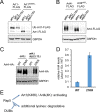Deubiquitinating enzymes Ubp2 and Ubp15 regulate endocytosis by limiting ubiquitination and degradation of ARTs
- PMID: 28298493
- PMCID: PMC5415021
- DOI: 10.1091/mbc.E17-01-0008
Deubiquitinating enzymes Ubp2 and Ubp15 regulate endocytosis by limiting ubiquitination and degradation of ARTs
Abstract
Endocytic down-regulation of cell-surface proteins is a fundamental cellular process for cell survival and adaptation to environmental stimuli. Ubiquitination of cargo proteins serves as the sorting signal for downstream trafficking and relies on the arrestin-related trafficking adaptor (ART)-Rsp5 ubiquitin ligase adaptor network in yeast. Hence proper regulation of the abundance and activity of these ligase-adaptor complexes is critical for main-tenance of optimal plasma membrane protein composition. Here we report that the stability of ARTs is regulated by the deubiquitinating enzymes (DUBs) Ubp2 and Ubp15. By counteracting the E3 ubiquitin ligase Rsp5, Ubp2 and Ubp15 prevent hyperubiquitination and proteasomal degradation of ARTs. Specifically, we show that loss of both Ubp2 and Ubp15 results in a defect in Hxt6 endocytosis associated with Art4 instability. Our results uncover a novel function for DUBs in the endocytic pathway by which Ubp2 and Ubp15 positively regulate the ART-Rsp5 network.
© 2017 Ho et al. This article is distributed by The American Society for Cell Biology under license from the author(s). Two months after publication it is available to the public under an Attribution–Noncommercial–Share Alike 3.0 Unported Creative Commons License (http://creativecommons.org/licenses/by-nc-sa/3.0).
Figures








Similar articles
-
Interaction of the deubiquitinating enzyme Ubp2 and the e3 ligase Rsp5 is required for transporter/receptor sorting in the multivesicular body pathway.PLoS One. 2009;4(1):e4259. doi: 10.1371/journal.pone.0004259. Epub 2009 Jan 23. PLoS One. 2009. PMID: 19165343 Free PMC article.
-
Deubiquitinase activity is required for the proteasomal degradation of misfolded cytosolic proteins upon heat-stress.Nat Commun. 2016 Oct 4;7:12907. doi: 10.1038/ncomms12907. Nat Commun. 2016. PMID: 27698423 Free PMC article.
-
The Rsp5 ubiquitin ligase is coupled to and antagonized by the Ubp2 deubiquitinating enzyme.EMBO J. 2005 Jul 6;24(13):2414-24. doi: 10.1038/sj.emboj.7600710. Epub 2005 Jun 2. EMBO J. 2005. PMID: 15933713 Free PMC article.
-
The α-arrestin family of ubiquitin ligase adaptors links metabolism with selective endocytosis.Biol Cell. 2021 Apr;113(4):183-219. doi: 10.1111/boc.202000137. Epub 2021 Feb 1. Biol Cell. 2021. PMID: 33314196 Review.
-
Ubiquitin and endocytic protein sorting.Essays Biochem. 2005;41:81-98. doi: 10.1042/EB0410081. Essays Biochem. 2005. PMID: 16250899 Review.
Cited by
-
Ubiquitin and its relatives as wizards of the endolysosomal system.J Cell Sci. 2023 Feb 15;136(4):jcs260101. doi: 10.1242/jcs.260101. Epub 2023 Feb 24. J Cell Sci. 2023. PMID: 36825571 Free PMC article.
-
The Bul1/2 Alpha-Arrestins Promote Ubiquitylation and Endocytosis of the Can1 Permease upon Cycloheximide-Induced TORC1-Hyperactivation.Int J Mol Sci. 2021 Sep 22;22(19):10208. doi: 10.3390/ijms221910208. Int J Mol Sci. 2021. PMID: 34638549 Free PMC article.
-
Methionine triggers Ppz-mediated dephosphorylation of Art1 to promote cargo-specific endocytosis.J Cell Biol. 2019 Mar 4;218(3):977-992. doi: 10.1083/jcb.201712144. Epub 2019 Jan 4. J Cell Biol. 2019. PMID: 30610170 Free PMC article.
-
Tracking yeast pheromone receptor Ste2 endocytosis using fluorogen-activating protein tagging.Mol Biol Cell. 2018 Nov 1;29(22):2720-2736. doi: 10.1091/mbc.E18-07-0424. Epub 2018 Sep 12. Mol Biol Cell. 2018. PMID: 30207829 Free PMC article.
-
TORC1 Signaling Controls the Stability and Function of α-Arrestins Aly1 and Aly2.Biomolecules. 2022 Mar 31;12(4):533. doi: 10.3390/biom12040533. Biomolecules. 2022. PMID: 35454122 Free PMC article.
References
-
- Alvaro CG, O’Donnell AF, Prosser DC, Augustine AA, Goldman A, Brodsky JL, Cyert MS, Wendland B, Thorner J. Specific alpha-arrestins negatively regulate Saccharomyces cerevisiae pheromone response by down-modulating the G-protein-coupled receptor Ste2. Mol Cell Biol. 2014;34:2660–2681. - PMC - PubMed
-
- Amerik AY, Hochstrasser M. Mechanism and function of deubiquitinating enzymes. Biochim Biophys Acta. 2004;1695:189–207. - PubMed
-
- Amerik AY, Li SJ, Hochstrasser M. Analysis of the deubiquitinating enzymes of the yeast Saccharomyces cerevisiae. Biol Chem. 2000a;381:981–992. - PubMed
MeSH terms
Substances
Grants and funding
LinkOut - more resources
Full Text Sources
Other Literature Sources
Molecular Biology Databases

